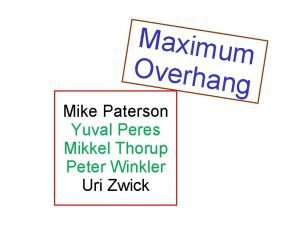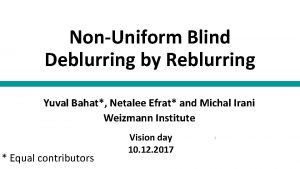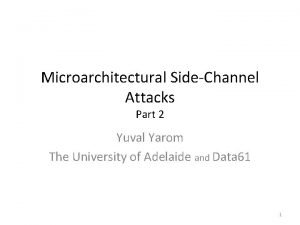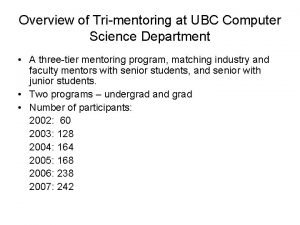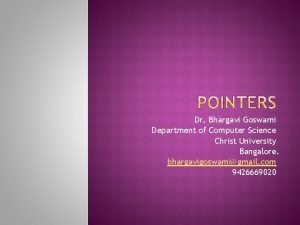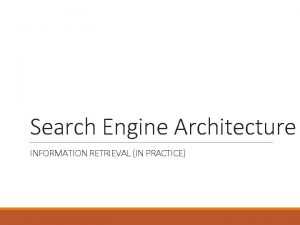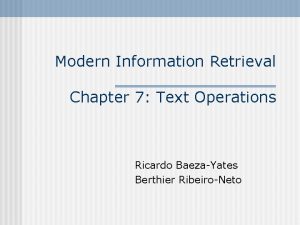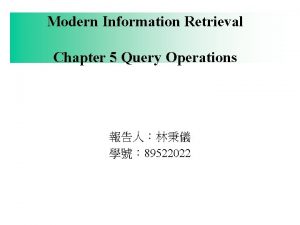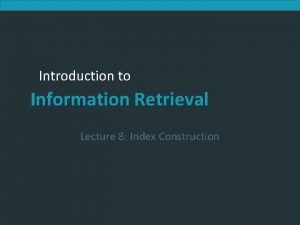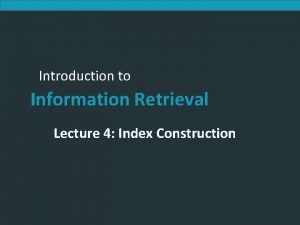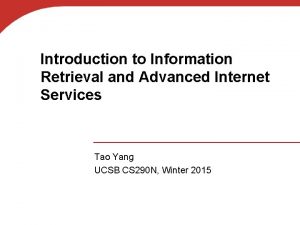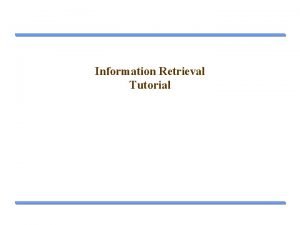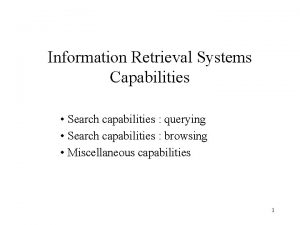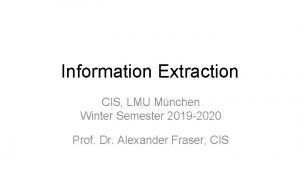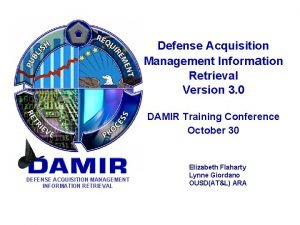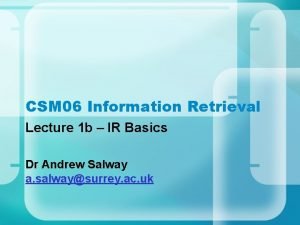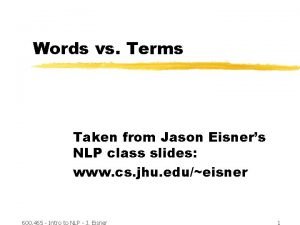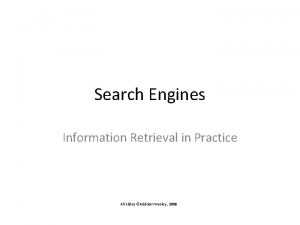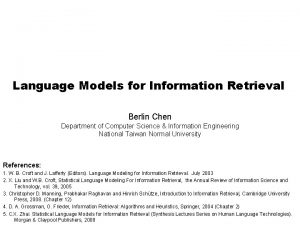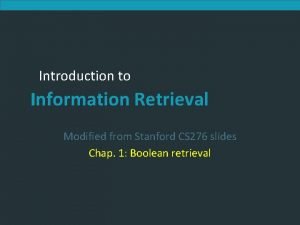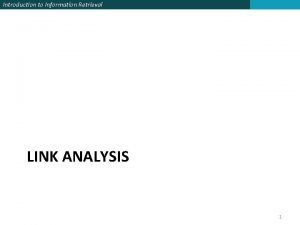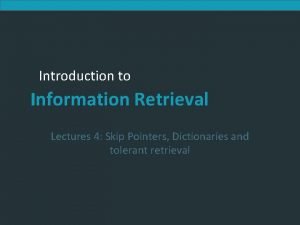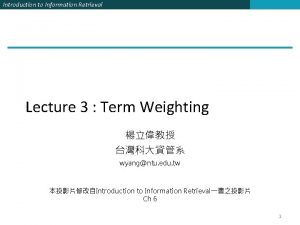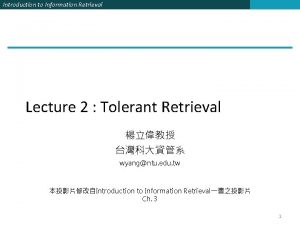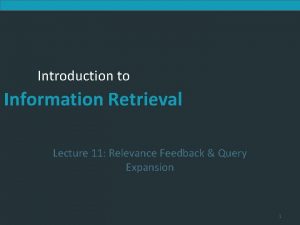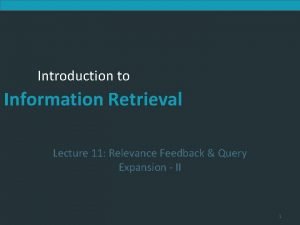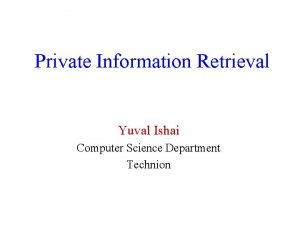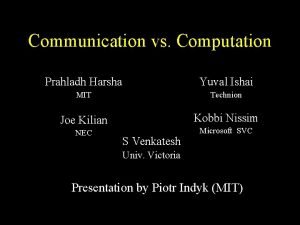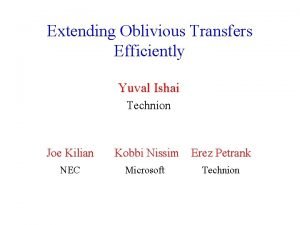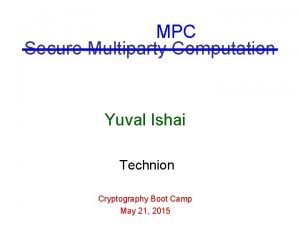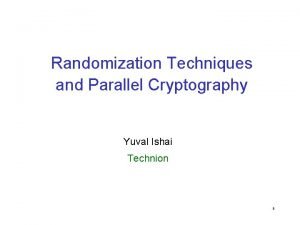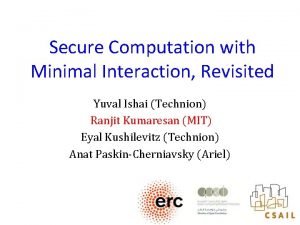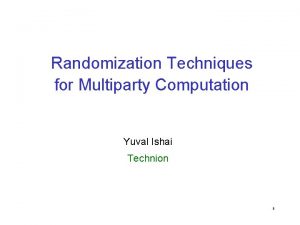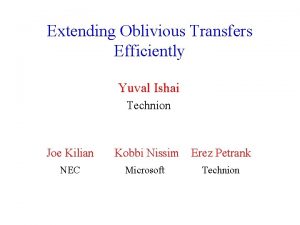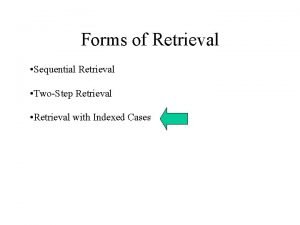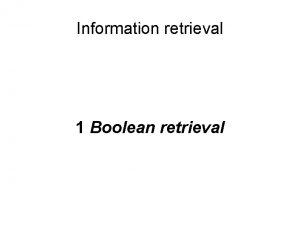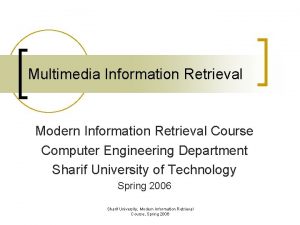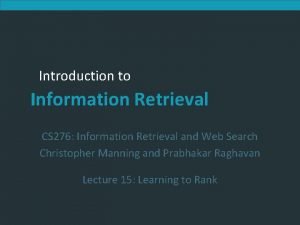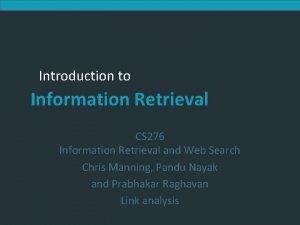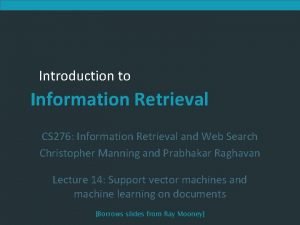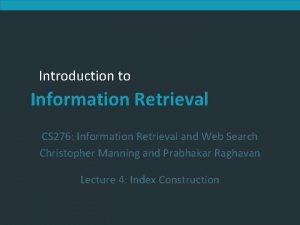Private Information Retrieval Yuval Ishai Computer Science Department


![Private Information Retrieval (PIR) [CGKS 95] • Goal: allow a user to access a Private Information Retrieval (PIR) [CGKS 95] • Goal: allow a user to access a](https://slidetodoc.com/presentation_image_h2/d45dc4ab74f491406419ad765bc53a83/image-3.jpg)


![Two Approaches Computational PIR [KO 97, CMS 99, . . . ] Computational privacy, Two Approaches Computational PIR [KO 97, CMS 99, . . . ] Computational privacy,](https://slidetodoc.com/presentation_image_h2/d45dc4ab74f491406419ad765bc53a83/image-6.jpg)



![Bounds for Computational PIR servers comm. assumption [CG 97] 2 O(n ) [KO 97] Bounds for Computational PIR servers comm. assumption [CG 97] 2 O(n ) [KO 97]](https://slidetodoc.com/presentation_image_h2/d45dc4ab74f491406419ad765bc53a83/image-10.jpg)


![Locally Decodable Codes [KT 00] x y i Requirements: • High fault-tolerance • Local Locally Decodable Codes [KT 00] x y i Requirements: • High fault-tolerance • Local](https://slidetodoc.com/presentation_image_h2/d45dc4ab74f491406419ad765bc53a83/image-13.jpg)



![Connecting MPC and LDC [IK 04] 1990 [KT 00] 1995 2000 • The three Connecting MPC and LDC [IK 04] 1990 [KT 00] 1995 2000 • The three](https://slidetodoc.com/presentation_image_h2/d45dc4ab74f491406419ad765bc53a83/image-17.jpg)

![PIR as a Building Block • Private storage [OS 98] • Sublinear-communication secure computation PIR as a Building Block • Private storage [OS 98] • Sublinear-communication secure computation](https://slidetodoc.com/presentation_image_h2/d45dc4ab74f491406419ad765bc53a83/image-19.jpg)






![Improved Variant [WY 05] • Goal: user learns P(z) without revealing z. • Step Improved Variant [WY 05] • Goal: user learns P(z) without revealing z. • Step](https://slidetodoc.com/presentation_image_h2/d45dc4ab74f491406419ad765bc53a83/image-26.jpg)
![Breaking the O(n 1/(2 k-1)) Barrier [BIKR 02] k=2 k=3 k=4 k=5 k=6 Breaking the O(n 1/(2 k-1)) Barrier [BIKR 02] k=2 k=3 k=4 k=5 k=6](https://slidetodoc.com/presentation_image_h2/d45dc4ab74f491406419ad765bc53a83/image-27.jpg)


![Degree Reduction Using Partial Information ]BKL 95, BI 01] P S 1 P S Degree Reduction Using Partial Information ]BKL 95, BI 01] P S 1 P S](https://slidetodoc.com/presentation_image_h2/d45dc4ab74f491406419ad765bc53a83/image-30.jpg)










- Slides: 40

Private Information Retrieval Yuval Ishai Computer Science Department Technion

Talk Overview • Intro to PIR – Motivation and problem definition – Toy examples – State of the art • Relation with other primitives – Locally Decodable Codes – (Oblivious Transfer, CRHF) • Constructions • Open problems
![Private Information Retrieval PIR CGKS 95 Goal allow a user to access a Private Information Retrieval (PIR) [CGKS 95] • Goal: allow a user to access a](https://slidetodoc.com/presentation_image_h2/d45dc4ab74f491406419ad765bc53a83/image-3.jpg)
Private Information Retrieval (PIR) [CGKS 95] • Goal: allow a user to access a database while hiding what she is after. • Motivation: patent databases, web searches, etc. • Paradox(? ) : imagine buying in a store without the seller knowing what you buy. Note: Encrypting requests is useful against third parties; not against server holding the data.

Modeling Server ? ? ? xi User

Some “solutions” 1. User downloads entire database. Drawback: n communication bits (vs. logn+1 w/o privacy). Main research goal: minimize communication complexity. 2. User masks i with additional random indices. Drawback: gives a lot of information about i. 3. Enable anonymous access to database. Addresses a different concern: hides identity of user, not the fact that xi is retrieved. Fact: PIR as described so far requires (n) communication bits.
![Two Approaches Computational PIR KO 97 CMS 99 Computational privacy Two Approaches Computational PIR [KO 97, CMS 99, . . . ] Computational privacy,](https://slidetodoc.com/presentation_image_h2/d45dc4ab74f491406419ad765bc53a83/image-6.jpg)
Two Approaches Computational PIR [KO 97, CMS 99, . . . ] Computational privacy, based on cryptographic assumptions. Information-Theoretic PIR [CGKS 95, Amb 97, . . . ] Replicate database among k servers. Unconditional privacy against t servers. Default: t=1

Model for I. T. PIR X X S 1 S 2 ? ? ? X Sk ? ? ? xi User i

Information-Theoretic PIR for Dummies n 1/2 X S 1 n 1/2 S 2 i a 1=X·q 1 q 2 q 1 + q 2 = ei i a 2=X·q 2 a 1+a 2=X·ei U 2 -server PIR with O(n 1/2) communication

Computational PIR for Dummies Tool: homomorphic encryption a b Protocol: = a+b • User sends E(ei) E(0) E(1) E(0) (=c 1 c 2 c 3 c 4) X= n 1/2 0110 1 1 1 0 n 1/2 1100 0001 • Server replies with E(X·ei) c 2 c 3 c 1 c 2 c 4 • User recovers ith column of X i PIR with ~ O(n 1/2) communication
![Bounds for Computational PIR servers comm assumption CG 97 2 On KO 97 Bounds for Computational PIR servers comm. assumption [CG 97] 2 O(n ) [KO 97]](https://slidetodoc.com/presentation_image_h2/d45dc4ab74f491406419ad765bc53a83/image-10.jpg)
Bounds for Computational PIR servers comm. assumption [CG 97] 2 O(n ) [KO 97] 1 O(n ) one-way function homomorphic QRA / encryption [CMS 99] 1 polylog(n) -hiding … DCRA [Lipmaa] [KO 00] 1 n-o(n) trapdoor permutation

Bounds for I. T. PIR Upper bounds: – O(log n / loglog n) servers, polylog(n) [BF 90, BFKR 91, CGKS 95] – 2 servers, O(n 1/3); k servers, O(n 1/k) [CGKS 95] – k servers, O(n 1/(2 k-1)) [Amb 97, Ito 99, IK 99, BI 01, WY 05] • t-private, O(nt/(2 k-1)) [BI 01, WY 05] – k servers, O(ncloglogk /(klogk)) [BIKR 02]. BIKR “dirty” AMB CGKS “clean” inefficient IK BI WY efficient Lower bounds: – log n +1 (no privacy) – 2 servers, ~5 log n ; k servers, ck log n – Better for restricted 2 -server protocols [Man 98, Wd. W 04] [CGKS 95, GKST 02, BFG 02, Kd. W 03, Wd. W 04]

Why Information-Theoretic PIR? Cons: • Requires multiple servers • Privacy against limited collusions • Worse asymptotic complexity (with const. k): O(nc) vs. polylog(n) Pros: • • • Neat question Unconditional privacy Better “real-life” efficiency Allows very short queries or very short answers (+apps [DIO 98, BIM 99] ) Closely related to a natural coding problem [KT 00]
![Locally Decodable Codes KT 00 x y i Requirements High faulttolerance Local Locally Decodable Codes [KT 00] x y i Requirements: • High fault-tolerance • Local](https://slidetodoc.com/presentation_image_h2/d45dc4ab74f491406419ad765bc53a83/image-13.jpg)
Locally Decodable Codes [KT 00] x y i Requirements: • High fault-tolerance • Local decoding Recover from m faults… … with ½+ probability Question: how large should m(n) be in a k-query LDC? k=2: 2 (n) k=3: 2 O(n^ 0. 5) (n 2)

From I. T. PIR to LDC k-server PIR with -bit queries and -bit answers k-query LDC of length 2 over ={0, 1} y[q]=Answer(x, q) • Converse relation also holds. • Binary LDC PIR with one answer bit per server • Best known LDC are obtained from PIR protocols. – const. q: m=exp(nc loglogq / qlogq)

A Question about MPC Ben-Or, Goldwasser, Wigderson, 1988 Chaum, Crépeau, Damgård, 1988 Information-theoretic MPC is feasible! Beaver, Micali, Rogaway, 1990 B. , Feigenbaum, Kilian, R. , 1990 Open question: k 3 players can compute any function f of their inputs with total work = poly(circuit-size) Can k computationally unbounded players compute an arbitrary f with communication = poly(input-length)? … or with work = poly(formula-size) and constant rounds [BB 89, …] Can this be done using a constant number of rounds?

Question Reformulated Is the communication complexity of MPC strongly correlated with the computational complexity of the function being computed? All functions efficiently computable functions = communication-efficient MPC = no communication-efficient MPC
![Connecting MPC and LDC IK 04 1990 KT 00 1995 2000 The three Connecting MPC and LDC [IK 04] 1990 [KT 00] 1995 2000 • The three](https://slidetodoc.com/presentation_image_h2/d45dc4ab74f491406419ad765bc53a83/image-17.jpg)
Connecting MPC and LDC [IK 04] 1990 [KT 00] 1995 2000 • The three problems are “essentially equivalent” – up to considerable deterioration of parameters

c. PIR and the Crypto World Homomorphic Encryption Trapdoor Permutation* c. PIR OT KA Secure Computation CRHF* NI UH Commitment
![PIR as a Building Block Private storage OS 98 Sublinearcommunication secure computation PIR as a Building Block • Private storage [OS 98] • Sublinear-communication secure computation](https://slidetodoc.com/presentation_image_h2/d45dc4ab74f491406419ad765bc53a83/image-19.jpg)
PIR as a Building Block • Private storage [OS 98] • Sublinear-communication secure computation – – – 1 -out-of-n Oblivious Transfer (SPIR) [GIKM 98, NP 99, …] Keyword search [CGN 99, FIPR 05] Statistical queries ]CIKRRW 01[ Approximate distance ]FIMNSW 01, IW 04[ Communication-preserving secure function evaluation [NN 01]

Time Complexity of PIR Focus so far: communication complexity Obstacle: time complexity • Server/s must spend at least linear time. Workarounds: • Preprocessing [BIM 00] • Amortization [BIM 00, IKOS 04] Non-adaptive Adaptive Single user ? Multiple users ? ?

Protocols

• High level structure of all known protocols – User maps i into a point z Fm – User secret-shares z between servers using some t-threshold LSSS over F – Server j responds with a linear function of x determined by its share of z. • Two types of protocols: – Polynomial-based [BF 90, BFKR 91, CGKS 95, …, WY 05] • LSSS = Shamir • Scale well with k, t – Replication-based • • [IK 99, BI 01, BIKR 02] LSSS = CNF Do not scale well with k, t - involve (k choose t) replication overhead However, dominate over polynomial-based up to (k choose t) factor [CDI 05] Best known protocols for constant k

Polynomial-Based Protocols • Step 1: Arithmetization – Fix a degree parameter d (will be determined by k) • Goal: Communication = O(n 1/d) – User maps i [n] into a weight-d vector z of length m=O(n 1/d). • 1 11100…. 0 2 11010… 0 n 00… 0111 – Servers view x as a degree-d m-variate polynomial P(Z 1, …, Zm)= x 1 Z 1 Z 2 Z 3 + x 2 Z 1 Z 2 Z 4 + … + xn. Zm-2 Zm-1 Zm – Privately retrieving i-th bit of x privately evaluating P on z.

Basic Protocol: t=1 • Goal: user learns P(z) without revealing z. • Step 2: Secret Sharing of z t=1: • Pick random “direction” Fm • z = z+j goes to S j j t =1 z z+4 z+3 z+2 z+ Fm • Step 3: Sj responds with P(zj) – User can extrapolate P(z) from P(z 1), …, p(zk) if k>d. • Define deg-d univariate poly Q(W)=P(z+W ) • Q(0)=P(z) can be extrapolated from d+1 distinct values Q(j)=P(zj) Ø Query length m=O(n 1/d), answer length 1 Ø Using k servers, O(n 1/k-1) communication

Basic Protocol: General t • Goal: user learns P(z) without revealing z. • Step 2: Secret Sharing of z General t: • zj = z+j 1+j 2 2+…+jt t • Step 3: Sj responds with P(zj) z Fm – User can extrapolate P(z) from P(z 1), …, P(zk) if k>dt. • Define deg-dt univariate poly Q(W)=P(z+W 1+W 2 2+…+Wt t) • P(z)=Q(0) can be extrapolated from dt+1 distinct values q(j) Ø O(n 1/d) communication using k=dt+1 servers.
![Improved Variant WY 05 Goal user learns Pz without revealing z Step Improved Variant [WY 05] • Goal: user learns P(z) without revealing z. • Step](https://slidetodoc.com/presentation_image_h2/d45dc4ab74f491406419ad765bc53a83/image-26.jpg)
Improved Variant [WY 05] • Goal: user learns P(z) without revealing z. • Step 2: Secret Sharing of z General t: • zj = z+j 1+j 2 2+…+jt t • Step 3: Sj responds with P(zj) along with all m partial derivatives of P evaluated at zj – User can extrapolate P(z) if k>dt/2. • Define deg-dt univariate poly Q(W)=P(z+W 1+W 2 2+…+Wt t) • P(z)=Q(0) can be extrapolated from 2 k>dt distinct values Q(j), Q’(j) • Complexity: O(m) communication both ways Ø Same communication using half as many servers!
![Breaking the On 12 k1 Barrier BIKR 02 k2 k3 k4 k5 k6 Breaking the O(n 1/(2 k-1)) Barrier [BIKR 02] k=2 k=3 k=4 k=5 k=6](https://slidetodoc.com/presentation_image_h2/d45dc4ab74f491406419ad765bc53a83/image-27.jpg)
Breaking the O(n 1/(2 k-1)) Barrier [BIKR 02] k=2 k=3 k=4 k=5 k=6

Arithmetization • As before, except that now F=GF(2) – Fix a degree parameter d (will be determined by k) • Goal: Communication = O(n 1/d) – User maps i [n] into a weight-d vector z of length m=O(n 1/d). • 1 11100…. 0 2 11010… 0 n 00… 0111 – Servers view x as a degree-d m-variate polynomial P(Z 1, …, Zm)= x 1 Z 1 Z 2 Z 3 + x 2 Z 1 Z 2 Z 4 + … + xn. Zm-2 Zm-1 Zm – Privately retrieving i-th bit of x privately evaluating P on z.

Effect of Degree Reduction degree d, m variables degree d/c, m variables size n size O(n 1/c)
![Degree Reduction Using Partial Information BKL 95 BI 01 P S 1 P S Degree Reduction Using Partial Information ]BKL 95, BI 01] P S 1 P S](https://slidetodoc.com/presentation_image_h2/d45dc4ab74f491406419ad765bc53a83/image-30.jpg)
Degree Reduction Using Partial Information ]BKL 95, BI 01] P S 1 P S 2 P Sk P(z) User z z is hidden from servers Q S 1 Q S 2 Q Sk Q(y) User y Each entry of y is known to all but one server.

k=3, d=6 S 1 S 2 S 3 Q= + + S 1 S 3 Q 1 + + S 1 Q 3 S 2 Q(y)=Q 1(y)+Q 2(y)+Q 3(y) deg. Qj d/k = 2 S 3

Back to PIR P P P S 1 S 2 Sk P(z) User z z is hidden from servers n comm. bits Q S 1 Q Q S 2 Sk Q(y) User y Each entry of y is known to all but one server. O(n 1/k) comm. bits Let z=y 1+…+ yk , where the yj are otherwise random Q(Y 1, …, Yk)= P(Y 1+… +Yk)

Initial Protocol O(m) = O(n 1/d) O(n 1/k) • User picks random y 1, …, yk s. t. y 1+…+ yk= z, and sends to Sj all y’s except yj. • Servers define an mk-variate degree-d polynomial Q(Y 1, …, Yk)= P(Y 1+… +Yk). • Each Sj computes degree-(d/k) poly. Qj , such that Q(y)= Q 1(y)+…+Qk(y). • Sj sends a description of Qj to User. • User computes Qj(y)=xi.

A Closer Look • M Sj missing at most d/k variables. deg Qj d/k Best previous binary PIR Best previous PIR Useful parameters: • d=k-1 query length O(n 1/(k-1)) d/k =0 answer length 1 • d=2 k-1 query length O(n 1/(2 k-1)) d/k =1 answer length O(n 1/(2 k-1))

Boosting the Integer Truncation Effect • Idea: apply multiple “partial” degree reduction steps. • Generalized degree reduction: Assign each monomial to the k’ servers V which jointly miss the least number of variables. k=3, d=6, k’=2 S 1 S 2 Q(y ) = S 3 Q= + + å QV (y ) |V | = k ' S 1 S 2 S 2 S 3 S 1 S 2 S 1 S 3

replication reduction k k’ reduction k” reduction … 1 degree d size n d’ n’=O(n d’/d) n”=O(n’ d ”/d’) … d” … n d/k /d d/k The missing operator: k conversion k d d’ n n #vars m m’=O(md/d’) Additional cost: re-distribute new point y’

Example: k=3 replication reduction 3 2 conversion 2 reduction 1 degree #vars 7 O(n 1/7) 4 O(n 1/7) 3 O(n 4/21) 1 O(n 4/21) Queries O(n 4/21) size n O(n 4/7) O(n 4/21) Answers communication

In Search of the Missing Operator P P’ d’, m’ P(y)=P’(y’) d, m y y’ Must have m’= (md/d’). Question: For which d’<d can get m’=O(md/d’)? • Possible when d’|d. • Open otherwise. Positive result Better PIR • Simplest open case: d=3, d’=2, m’=O(m 3/2)

A Workaround • Can’t solve the polynomial conversion problem in general. • … but easy to solve given the promise weight(y)=const. • Stronger degree reduction: • Main technical lemma: good parameters for strong degree reduction.

Open Problems • Better upper bounds – Known: O(ncloglogk /(klogk)) – What is the true limit of our technique? • Generalize best upper bound to t>1 • Tight bounds for polynomial conversion • Lower bounds – Known: clogn – Simplest cases: • k=2 • k=3, single answer bit per server
 Yuval binur
Yuval binur Yuval binur
Yuval binur Yuval peres
Yuval peres Exhibinition
Exhibinition Yuval bahat
Yuval bahat Yuval yarom
Yuval yarom Ucl computer science faculty
Ucl computer science faculty Northwestern electrical engineering
Northwestern electrical engineering Computer science department rutgers
Computer science department rutgers Vptl tutoring stanford
Vptl tutoring stanford Fsu cybersecurity major
Fsu cybersecurity major Trimentoring
Trimentoring Bhargavi goswami
Bhargavi goswami Mice.cs.columbia
Mice.cs.columbia Algorithm for sequential search
Algorithm for sequential search Components of search engine in information retrieval
Components of search engine in information retrieval Information retrieval evaluation
Information retrieval evaluation Modern information retrieval
Modern information retrieval Query operations in information retrieval
Query operations in information retrieval Positional index information retrieval
Positional index information retrieval Index construction in information retrieval
Index construction in information retrieval Spimi
Spimi Which internet service is used for information retrieval
Which internet service is used for information retrieval Information retrieval tutorial
Information retrieval tutorial Wildcard queries in information retrieval
Wildcard queries in information retrieval Information retrieval system capabilities
Information retrieval system capabilities Link analysis in information retrieval
Link analysis in information retrieval Information retrieval lmu
Information retrieval lmu Defense acquisition management information retrieval
Defense acquisition management information retrieval Advantages of information retrieval system
Advantages of information retrieval system Information retrieval nlp
Information retrieval nlp Information retrieval data structures and algorithms
Information retrieval data structures and algorithms Information retrieval slides
Information retrieval slides Relevance information retrieval
Relevance information retrieval Stanford information retrieval
Stanford information retrieval Link analysis in information retrieval
Link analysis in information retrieval Which is a good idea for using skip pointers
Which is a good idea for using skip pointers Log frequency weighting
Log frequency weighting Levenshtein distance for oslo-snow
Levenshtein distance for oslo-snow Information retrieval
Information retrieval Information retrieval
Information retrieval


